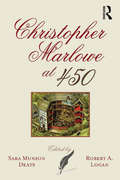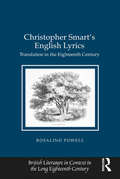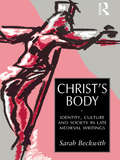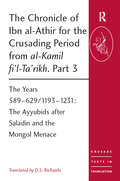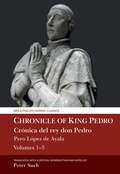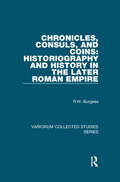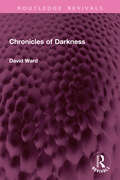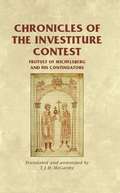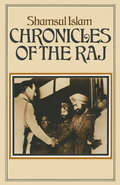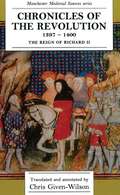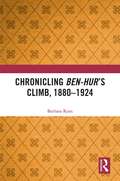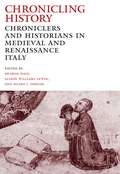- Table View
- List View
Christopher Marlowe and the Failure to Unify (Studies in Performance and Early Modern Drama)
by Andrew DuxfieldIn this sustained full length study of Marlowe's plays, Andrew Duxfield argues that Marlovian drama exhibits a marked interest in unity and unification, and that in doing so it engages with a discourse of anxiety over social discord that was prominent in the 1580s and 1590s. In combination with the ambiguity of the plays, he suggests, this focus produces a tension that both heightens dramatic effect and facilitates a cynical response to contemporary evocations of and pleas for unity. This book has three main aims. Firstly, it establishes that Marlowe’s tragedies exhibit a profound interest in the process of reduction and the ideal of unity. Duxfield shows this interest to manifest itself in different ways in each of the plays. Secondly, it identifies this interest in unity and unification as an engagement in a cultural discourse that was particularly prevalent in England during Marlowe’s writing career; during the late 1580s and early 1590s heightened inter-confessional tension, the threat and reality of foreign invasion and public puritan dissent in the form of the Marprelate controversy provoked considerable public anxiety about social discord. Thirdly, the book considers the plays’ focus on unity in relation to their marked ambiguity; throughout all of the plays, unifying ideals and reductive processes are consistently subject to renegotiation with, or undercut entirely by, the complexity and ambiguity of the dramas in which they feature. Duxfield’s focus on unity as a theme throughout the plays provides a new lens through which to examine the place of Marlowe’s work in its cultural moment.
Christopher Marlowe at 450
by Sara Munson Deats Robert A. LoganThere has never been a retrospective on Christopher Marlowe as comprehensive, complete and up-to-date in appraising the Marlovian landscape. Each chapter has been written by an eminent, international Marlovian scholar to determine what has been covered, what has not, and what scholarship and criticism will or might focus on next. The volume considers all of Marlowe’s dramas and his poetry, including his translations, as well as the following special topics: Critical Approaches to Marlowe; Marlowe’s Works in Performance; Marlowe and Theatre History; Electronic Resources for Marlovian Research; and Marlowe’s Biography. Included in the discussions are the native, continental, and classical influences on Marlowe and the ways in which Marlowe has interacted with other contemporary writers, including his influence on those who came after him. The volume has appeal not only to students and scholars of Marlowe but to anyone interested in Renaissance drama and poetry. Moreover, the significance for readers lies in the contributors’ approaches as well as in their content. Interest in the biography of Christopher Marlowe and in his works has bourgeoned since the turn of the century. It therefore seems especially appropriate at this time to present a comprehensive assessment of past and present traditional and innovative lines of inquiry and to look forward to future developments.
Christopher Marlowe at 450
by Sara Munson Deats Robert A. LoganThere has never been a retrospective on Christopher Marlowe as comprehensive, complete and up-to-date in appraising the Marlovian landscape. Each chapter has been written by an eminent, international Marlovian scholar to determine what has been covered, what has not, and what scholarship and criticism will or might focus on next. The volume considers all of Marlowe’s dramas and his poetry, including his translations, as well as the following special topics: Critical Approaches to Marlowe; Marlowe’s Works in Performance; Marlowe and Theatre History; Electronic Resources for Marlovian Research; and Marlowe’s Biography. Included in the discussions are the native, continental, and classical influences on Marlowe and the ways in which Marlowe has interacted with other contemporary writers, including his influence on those who came after him. The volume has appeal not only to students and scholars of Marlowe but to anyone interested in Renaissance drama and poetry. Moreover, the significance for readers lies in the contributors’ approaches as well as in their content. Interest in the biography of Christopher Marlowe and in his works has bourgeoned since the turn of the century. It therefore seems especially appropriate at this time to present a comprehensive assessment of past and present traditional and innovative lines of inquiry and to look forward to future developments.
A Christopher Marlowe Chronology (Author Chronologies Series)
by L. HopkinsThis new Chronology offers a unique and accessible overview of key dates relevant to Christopher Marlowe's life and works, and enables readers to navigate their way through the various pieces of evidence for the hotly contested dating of his plays and poems. Since Marlowe's plays often focus on real historical figures, details of their lives are also included to allow readers to see what liberties Marlowe has taken in his dramatizations of their lives.
Christopher Marlowe the Craftsman: Lives, Stage, and Page
by M.L. StapletonContributions to this volume explore the idea of Marlowe as a working artist, in keeping with John Addington Symonds' characterization of him as a "sculptor-poet." Throughout the body of his work-including not only the poems and plays, but also his forays into translation and imitation-a distinguished company of established and emerging literary scholars traces how Marlowe conceives an idea, shapes and refines it, then remakes and remodels it, only to refashion it further in his writing process. These essays necessarily overlap with one another in the categories of lives, stage, and page, which signals their interdependent nature regarding questions of authorship, theater and performance history, as well as interpretive issues within the works themselves. The contributors interpret and analyze the disputed facts of Marlowe's life, the textual difficulties that emerge from the staging of his plays, the critical investigations arising from analyses of individual works, and their relationship to those of his contemporaries. The collection engages in new ways the controversies and complexities of its subject's life and art. It reflects the flourishing state of Marlowe studies as it shapes the twenty-first century conception of the poet and playwright as master craftsman.
Christopher Marlowe the Craftsman: Lives, Stage, and Page
by M.L. StapletonContributions to this volume explore the idea of Marlowe as a working artist, in keeping with John Addington Symonds' characterization of him as a "sculptor-poet." Throughout the body of his work-including not only the poems and plays, but also his forays into translation and imitation-a distinguished company of established and emerging literary scholars traces how Marlowe conceives an idea, shapes and refines it, then remakes and remodels it, only to refashion it further in his writing process. These essays necessarily overlap with one another in the categories of lives, stage, and page, which signals their interdependent nature regarding questions of authorship, theater and performance history, as well as interpretive issues within the works themselves. The contributors interpret and analyze the disputed facts of Marlowe's life, the textual difficulties that emerge from the staging of his plays, the critical investigations arising from analyses of individual works, and their relationship to those of his contemporaries. The collection engages in new ways the controversies and complexities of its subject's life and art. It reflects the flourishing state of Marlowe studies as it shapes the twenty-first century conception of the poet and playwright as master craftsman.
Christopher Smart and Satire: 'Mary Midnight' and the Midwife
by Min WildChristopher Smart and Satire explores the lively and idiosyncratic world of satire in the eighteenth-century periodical, focusing on the way that writers adopted personae to engage with debates taking place during the British Enlightenment. Taking Christopher Smart's audacious and hitherto underexplored Midwife, or Old Woman's Magazine (1750-1753) as her primary source, Min Wild provides a rich examination of the prizewinning Cambridge poet's adoption of the bizarre, sardonic 'Mary Midnight' as his alter-ego. Her analysis provides insights into the difficult position in which eighteenth-century writers were placed, as ideas regarding the nature and functions of authorship were gradually being transformed. At the same time, Wild also demonstrates that Smart's use of 'Mary Midnight' is part of a tradition of learned wit, having an established history and characterized by identifiable satirical and rhetorical techniques. Wild's engagement with her exuberant source materials establishes the skill and ingenuity of Smart's often undervalued, multilayered prose satire. As she explores Smart's use of a peculiarly female voice, Wild offers us a picture of an ingenious and ribald wit whose satirical overview of society explores, overturns, and anatomises questions of gender, politics, and scientific and literary endeavors.
Christopher Smart and Satire: 'Mary Midnight' and the Midwife
by Min WildChristopher Smart and Satire explores the lively and idiosyncratic world of satire in the eighteenth-century periodical, focusing on the way that writers adopted personae to engage with debates taking place during the British Enlightenment. Taking Christopher Smart's audacious and hitherto underexplored Midwife, or Old Woman's Magazine (1750-1753) as her primary source, Min Wild provides a rich examination of the prizewinning Cambridge poet's adoption of the bizarre, sardonic 'Mary Midnight' as his alter-ego. Her analysis provides insights into the difficult position in which eighteenth-century writers were placed, as ideas regarding the nature and functions of authorship were gradually being transformed. At the same time, Wild also demonstrates that Smart's use of 'Mary Midnight' is part of a tradition of learned wit, having an established history and characterized by identifiable satirical and rhetorical techniques. Wild's engagement with her exuberant source materials establishes the skill and ingenuity of Smart's often undervalued, multilayered prose satire. As she explores Smart's use of a peculiarly female voice, Wild offers us a picture of an ingenious and ribald wit whose satirical overview of society explores, overturns, and anatomises questions of gender, politics, and scientific and literary endeavors.
Christopher Smart's English Lyrics: Translation in the Eighteenth Century (British Literature in Context in the Long Eighteenth Century)
by Rosalind PowellIn the first full-length study of Christopher Smart’s translations and the place and function of translation in Smart’s poetry, Rosalind Powell proposes a new approach to understanding the relationship between Smart’s poetics and his practice. Drawing on translation theory from the early modern period to the present day, this book addresses Smart's translations of Horace, Phaedrus and the Psalms alongside the better-known religious works such as Jubilate Agno and A Song to David. Five recurrent threads run throughout Powell’s study: the effect of translation on the identity of a narrative voice in a rewritten text; the techniques that are used to present translated texts to a new literary, cultural and linguistic readership; performance and reading contexts; the translation of great works as an attempt to achieve literary permanence; and, finally, the authorial influence of Smart himself in terms of the overt religiosity and nationalism that he champions in his writing. In exploring Smart’s major translation projects and revisiting his original poems, Powell offers insights into classical reception and translation theory; attitudes towards censorship; expressions of nationalism in the period; developments in liturgy and hymnody; and the composition of children’s books and school texts in the early modern era. Her detailed analysis of Smart’s translating poetics places them within a new, contemporary context and locality to uncover the poet's works as a coherent project of Englishing.
Christopher Smart's English Lyrics: Translation in the Eighteenth Century (British Literature in Context in the Long Eighteenth Century)
by Rosalind PowellIn the first full-length study of Christopher Smart’s translations and the place and function of translation in Smart’s poetry, Rosalind Powell proposes a new approach to understanding the relationship between Smart’s poetics and his practice. Drawing on translation theory from the early modern period to the present day, this book addresses Smart's translations of Horace, Phaedrus and the Psalms alongside the better-known religious works such as Jubilate Agno and A Song to David. Five recurrent threads run throughout Powell’s study: the effect of translation on the identity of a narrative voice in a rewritten text; the techniques that are used to present translated texts to a new literary, cultural and linguistic readership; performance and reading contexts; the translation of great works as an attempt to achieve literary permanence; and, finally, the authorial influence of Smart himself in terms of the overt religiosity and nationalism that he champions in his writing. In exploring Smart’s major translation projects and revisiting his original poems, Powell offers insights into classical reception and translation theory; attitudes towards censorship; expressions of nationalism in the period; developments in liturgy and hymnody; and the composition of children’s books and school texts in the early modern era. Her detailed analysis of Smart’s translating poetics places them within a new, contemporary context and locality to uncover the poet's works as a coherent project of Englishing.
Christ's Body: Identity, Culture and Society in Late Medieval Writings
by Sarah BeckwithAt the very heart of Christian doctrine and late medieval practice was the image of the crucified Christ. Sarah Beckwith examines the social meaning of this image across a range of key devotional English texts, using insights from anthropology and cultural studies. The image of the crucified Christ, she argues, acted as a place where the tensions between the sacred and the profane, the individual and the collective, were played out. The medieval obsession with the contours of Christ's body functioned to challenge and transform social and political relations. A fascinating and challenging book of interest not only to students of medieval literature, but also to cultural historians and women's studies specialists.
Christ's Body: Identity, Culture and Society in Late Medieval Writings
by Sarah BeckwithAt the very heart of Christian doctrine and late medieval practice was the image of the crucified Christ. Sarah Beckwith examines the social meaning of this image across a range of key devotional English texts, using insights from anthropology and cultural studies. The image of the crucified Christ, she argues, acted as a place where the tensions between the sacred and the profane, the individual and the collective, were played out. The medieval obsession with the contours of Christ's body functioned to challenge and transform social and political relations. A fascinating and challenging book of interest not only to students of medieval literature, but also to cultural historians and women's studies specialists.
The Chronicle of Ibn al-Athir for the Crusading Period from al-Kamil fi'l-Ta'rikh. Part 3: The Years 589–629/1193–1231: The Ayyubids after Saladin and the Mongol Menace (Crusade Texts in Translation)
by D. S. RichardsThe Chronicle of Ibn al-Athir (1160-1233AD), entitled "al-Kamil fi'l-Ta'rikh", is one of the outstanding sources for the history of the mediaeval world. It covers the whole sweep of Islamic history almost up to the death of its author and, with the sources available to him, he attempted to embrace the widest geographical spread; events in Iraq, Iran and further East run in counterpoint with those involving North Africa and Spain. From the time of the arrival of the Crusaders in the Levant, their activities and the Muslim response become the focus of the work. A significant portion of this third part deals with the internal rivalries of the Ayyubid successors of Saladin, their changing relations with the Crusader states and in particular the events of the Damietta Crusade. As always, these events are portrayed against the wider background, with considerable emphasis on events in the eastern Islamic world, the fortunes of the Khwarazm Shahs and the first incursions of the Mongols.
The Chronicle of Ibn al-Athir for the Crusading Period from al-Kamil fi'l-Ta'rikh. Part 3: The Years 589–629/1193–1231: The Ayyubids after Saladin and the Mongol Menace (Crusade Texts in Translation)
by D. S. RichardsThe Chronicle of Ibn al-Athir (1160-1233AD), entitled "al-Kamil fi'l-Ta'rikh", is one of the outstanding sources for the history of the mediaeval world. It covers the whole sweep of Islamic history almost up to the death of its author and, with the sources available to him, he attempted to embrace the widest geographical spread; events in Iraq, Iran and further East run in counterpoint with those involving North Africa and Spain. From the time of the arrival of the Crusaders in the Levant, their activities and the Muslim response become the focus of the work. A significant portion of this third part deals with the internal rivalries of the Ayyubid successors of Saladin, their changing relations with the Crusader states and in particular the events of the Damietta Crusade. As always, these events are portrayed against the wider background, with considerable emphasis on events in the eastern Islamic world, the fortunes of the Khwarazm Shahs and the first incursions of the Mongols.
Chronicle of King Pedro Volumes 1 - 3: Pero López de Ayala (Aris & Phillips Hispanic Classics)
by Peter SuchPero López de Ayala’s Chronicle of King Pedro provides a compelling and richly informative account of the turbulent reign of the notorious but enigmatic fourteenth-century Castilian monarch who came to be known as Pedro el Cruel. It is a vitally important source for our understanding of the history of the Iberian Peninsula during this critical period in its development and of the complex social and political divisions by which the Spanish kingdoms were torn. This three-volume Chronicle gives us a gripping and wide-ranging picture of a period characterized by harsh brutality, conflict and betrayal but at the same time by the ideals of chivalry, memorably personified in figures such as the Black Prince and Bertrand du Guesclin. At its centre is the chilling portrait of King Pedro, a brilliantly constructed image of self-destructive evil. The translation is accompanied by a Spanish text taken from Germán Orduna’s groundbreaking edition and by detailed notes. The introduction explores the background to the Chronicle’s composition and sets López de Ayala’s account against a broad canvas of events in the Spanish kingdoms and beyond. It examines how the chronicler’s subtle artistry was used to create a picture of a deeply flawed monarch which has continued to exercise a profound fascination over the centuries.
Chronicles, Consuls, and Coins: Historiography and History in the Later Roman Empire
by R.W. BurgessThe papers collected in this volume focus on the sources for reconstructing the history of the third to fifth centuries AD. The first section, 'Historiography', looks at a small group of chronicles and breviaria whose texts are fundamental for our reconstruction of the history of the third and fourth centuries, some well known, others much less so: Eusebius of Caesarea, Jerome, the lost Kaisergeschichte, and Eutropius. In this section the goal in each case is a specific attempt to come to a better understanding of the structure, composition, date, or author of these historical texts. The second section, 'History', presents a group of historical studies, ranging in time from the death of Constantine in 337 to the vicennalia of Anastasius in 511. In these papers the keys to the conclusions offered arise from a better understanding of the literary sources - particularly chronicles and consularia -, an understanding of the evolution of historical accounts over time, or the employment of sources that are either new or unusual in these particular contexts: consular fasti, coins, papyri, and itineraries.
Chronicles, Consuls, and Coins: Historiography and History in the Later Roman Empire
by R.W. BurgessThe papers collected in this volume focus on the sources for reconstructing the history of the third to fifth centuries AD. The first section, 'Historiography', looks at a small group of chronicles and breviaria whose texts are fundamental for our reconstruction of the history of the third and fourth centuries, some well known, others much less so: Eusebius of Caesarea, Jerome, the lost Kaisergeschichte, and Eutropius. In this section the goal in each case is a specific attempt to come to a better understanding of the structure, composition, date, or author of these historical texts. The second section, 'History', presents a group of historical studies, ranging in time from the death of Constantine in 337 to the vicennalia of Anastasius in 511. In these papers the keys to the conclusions offered arise from a better understanding of the literary sources - particularly chronicles and consularia -, an understanding of the evolution of historical accounts over time, or the employment of sources that are either new or unusual in these particular contexts: consular fasti, coins, papyri, and itineraries.
Chronicles of Darkness (Routledge Revivals)
by David WardFirst published in 1989, Chronicles of Darkness is about images of Africa seen through the eyes of writers, visitors, residents, and native-born. They range from Joseph Conrad and Olive Schreiner, through Laurens van der Post, Karen Blixen and Evelyn Waugh, to more recent writers like Nadine Gordimer, Andre Brink and J.M. Coetzee.Such writers have frequently been faced with feelings of alienation, marginality, exile, self-consciousness, and egoism. It is only in this sense- that the eyes which see are shadowed and troubled- that Africa is a ‘dark continent’ and that these writings are ‘chronicles of darkness’. In some cases, Africa, even if merely a backdrop painted in crude and garish colors, becomes a way of revealing or admitting something about ‘Europe’ which might be concealed when a writer performs in a different theatre. This is an interesting read for scholars and researchers of English literature and African studies.
Chronicles of Darkness (Routledge Revivals)
by David WardFirst published in 1989, Chronicles of Darkness is about images of Africa seen through the eyes of writers, visitors, residents, and native-born. They range from Joseph Conrad and Olive Schreiner, through Laurens van der Post, Karen Blixen and Evelyn Waugh, to more recent writers like Nadine Gordimer, Andre Brink and J.M. Coetzee.Such writers have frequently been faced with feelings of alienation, marginality, exile, self-consciousness, and egoism. It is only in this sense- that the eyes which see are shadowed and troubled- that Africa is a ‘dark continent’ and that these writings are ‘chronicles of darkness’. In some cases, Africa, even if merely a backdrop painted in crude and garish colors, becomes a way of revealing or admitting something about ‘Europe’ which might be concealed when a writer performs in a different theatre. This is an interesting read for scholars and researchers of English literature and African studies.
Chronicles of the Investiture Contest: Frutolf of Michelsberg and his continuators (Manchester Medieval Sources)
by Rosemary Horrox Simon Maclean T. J. McCarthyThis book is the first English translation of one of the most significant chronicles of the Middle Ages. Written in Bamberg at the end of the eleventh century, Frutolf of Michelsberg’s Chronicle offers a lively and vivid account of the great struggle between the German emperors and the papacy known today as the Investiture Contest. Together with numerous continuations written in the first quarter of the twelfth century, Frutolf’s Chronicle offers an engaging and accessible snapshot of how medieval people reacted to a conflict that led to civil war in Germany and Italy, and fundamentally altered the relationship of church and state in Western society.
Chronicles of the Raj: A Study of Literary Reaction to the Imperial Idea towards the End of the Raj (pdf)
by Shamsul IslamChronicles of the Revolution, 1397–1400: The reign of Richard II (Manchester Medieval Sources)
by Chris Given-WilsonThis collection of sources covers one of the most controversial and shocking episodes in medieval English history, the 'tyranny' and deposition of Richard II and the usurpation of the throne by his cousin, Henry Bolingbroke, who became King Henry IV. Contemporaries were sharply divided about the rights and wrongs of both Richard and Henry, and this division is reflected in the texts which form the major part of these sources. All the principal contemporary chronicles are represented in this collection, from the violently partisan Thomas Walsingham, chronicler of St Alban's Abbey who saw Richard as a tyrant and murderer, to the indignant Dieulacres chronicler, who claimed that the 'innocent king' was tricked into surrender by his perjured barons.
Chronicling Ben-Hur’s Climb, 1880-1924
by Barbara RyanFirst published in 1880, Lew Wallace’s Ben-Hur is one of the best-selling novels of all time. Employing analytical strategies from the fields of literature, fan studies, reception history, and media research, Barbara Ryan traces Ben-Hur’s popularity from 1880 to 1924. She analyzes fan mail as well as a wide range of manuscript and print sources, using as her starting place two letters in which admirers declared that they would rather be the author of Ben-Hur than to be President of the United States. Ryan’s discussion of the novel in terms of its contemporary fandom makes it possible for her to dispel misconceptions about the novel’s audience which include assumptions about its popularity with all Christians. She makes fascinating connections between Ben-Hur, slavery discourse, and the changing nature of U.S. politics to challenge critics who assume that Wallace consciously used a sure-fire formula. By shedding light on attempts to squash the novel’s popularity, Ryan examines dramatizations of Ben-Hur by amateurs and on Broadway. Her in-depth reception history of Ben-Hur’s incarnations in print and on stage establishes the novel’s importance for understanding nineteenth-century U.S. literature, politics, and culture.
Chronicling Ben-Hur’s Climb, 1880-1924
by Barbara RyanFirst published in 1880, Lew Wallace’s Ben-Hur is one of the best-selling novels of all time. Employing analytical strategies from the fields of literature, fan studies, reception history, and media research, Barbara Ryan traces Ben-Hur’s popularity from 1880 to 1924. She analyzes fan mail as well as a wide range of manuscript and print sources, using as her starting place two letters in which admirers declared that they would rather be the author of Ben-Hur than to be President of the United States. Ryan’s discussion of the novel in terms of its contemporary fandom makes it possible for her to dispel misconceptions about the novel’s audience which include assumptions about its popularity with all Christians. She makes fascinating connections between Ben-Hur, slavery discourse, and the changing nature of U.S. politics to challenge critics who assume that Wallace consciously used a sure-fire formula. By shedding light on attempts to squash the novel’s popularity, Ryan examines dramatizations of Ben-Hur by amateurs and on Broadway. Her in-depth reception history of Ben-Hur’s incarnations in print and on stage establishes the novel’s importance for understanding nineteenth-century U.S. literature, politics, and culture.
Chronicling History: Chroniclers And Historians In Medieval And Renaissance Italy
by Sharon Dale Alison Williams Lewin Duane J. OsheimThis book examines historical writing from the late Middle Ages and Renaissance in Italy. Thousands of annals, chronicles, and histories were produced reflecting a complex society that evolved from the creation of the Lombard kingdom through the forging of a political order based on communes and finally into a system of regional Renaissance states. It is meant to serve as an introduction to this largely unappreciated historical resource.

